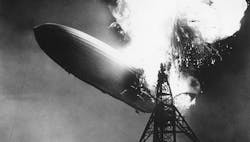Chemical Engineer Cracks Hindenburg Riddle
More at home with his research group focusing on fundamental surface dynamics and nanoscience, Konstantinos Giapis, professor of chemical engineering at the California Institute of Technology (Caltech), Pasadena, Calif., became an unlikely scientific sleuth when asked to investigate what really caused the Hindenburg disaster on May 6, 1937.
The 800-ft-long Zeppelin, containing 4,900,000 ft3 of hydrogen enclosed in 30,000 m2 of skin, was the pride of Germany’s Nazi regime. While preparing to land in Lakehurst, N.J., after a three-day voyage from Frankfurt, Germany, it was engulfed by flames and destroyed.
Of the 97 people on board, 35 died, plus a ground crew member who was crushed when part of the structure collapsed on him.
Giapis’ involvement began when NOVA, a television series focused on science on the U.S.’s Public Broadcasting Service, approached him to take a fresh look at the disaster.
After six months, and many chemical, engineering, physics, construction, material science and forensics hurdles later, he had solved the problem.
Using models of the skin and underlying structure, Giapis found stormy, wet weather on that day, coupled with the coatings used on the vessel’s fabric cover and the proximity of the skin to the metal structure below it effectively turned the Hindenburg into hundreds of highly charged capacitors shortly after it was grounded by mooring ropes.
The glowing aura seen on the upper hull by witnesses before dropping the mooring ropes was St. Elmo’s fire, a weak discharge indicative of high voltage present on the skin, he explains. Once the capacitors formed, it was only a matter of time before they charged up and caused sparks which then ignited a hydrogen leak near the rear of the vessel.
His key challenge was to mimic the formulation of the original coatings on the Hindenburg’s cotton canvas skin.
Some clues came from correspondence unearthed in the Zeppelin Museum, Friedrichshafen, Germany, between the company and the original polymer manufacturer Süddeutsche Lackfabrik Karl Wörwag, Stuttgart.
“This contained specific instructions on changing the plasticizers added to cellulose acetate butyrate (CAB) to improve ‘water tightness, flexibility and limited flammability’ properties of the dope. The exact plasticizers were a trade secret, likely kept at Wörwag,” he says.
Handily for a surface science specialist, the archives revealed information about the nominal size distribution and weight percentage of the red iron oxide particles and silver aluminum flakes added to the multiple layers of dope used on the Hindenburg.
“Particle size affects exposed surface area and has a significant impact on reactivity — a good chemical engineering topic in catalysis,” Giapis muses.
Then he turned his Caltech lab’s armory of analytical techniques on original Hindenburg skin samples to better understand their dope composition and electrical properties. X-ray photoelectron spectroscopy, thermogravimetric analysis, Fourier-transform infrared spectroscopy, UV/vis spectroscopy, energy dispersive X-ray spectroscopy and scanning electron microscopy were all employed.
“Age had left the originals deficient in hydrophobicity and flexibility, so their dielectric properties — hydrophobicity and dielectric strength are linked — were compromised, too,” he notes.
However, his analytical studies did reveal useful information about the composition of the dope, plasticizers and particles in the original samples. Using this, together with information found in original Zeppelin correspondence, he created his own CAB formulation to mimic that specification.
“I became proficient in painting dope on cloth to create original-quality Hindenburg skin — over 100 skin scaffolds, five layers each, with considerable drying time between layers,” says Giapis.
All of these exhibited high dielectric strength and had no charge leaks.
Happy that his efforts were as close as possible to the original, Giapis then made a model of part of the Hindenburg structure. The aluminium frame was separated from the skin with wooden pegs inserted between the two — as in the original. He sprayed the model with water to simulate rain.
Shortly after the frame was grounded with a simulated mooring rope, it accumulated enough electrical energy to produce sparks that could have ignited any nearby hydrogen.
Giapis says his efforts might not have a direct bearing on his current research activities, but admits to learning the importance of science in forensics.
“I was extremely impressed with something else, too: the high scientific standards of the NOVA program. They actually insisted on a peer-review of my experiments and theory by another reputable scientist! This is TV entertainment, but it must be based on sound science. I commend them for that.”
He also thanks Caltech because, although his lab had to shut down during the pandemic, he was allowed access as essential personnel. “I had plenty of time to play in the lab. It was fun and a way to keep my sanity.
“In the meantime, I’m looking for another mystery to solve,” he jokes.
For more see, www.pbs.org/wgbh/nova/video/hindenburg-the-new-evidence/
Seán Ottewell is Chemical Processing's editor at large. You can email him at [email protected].

